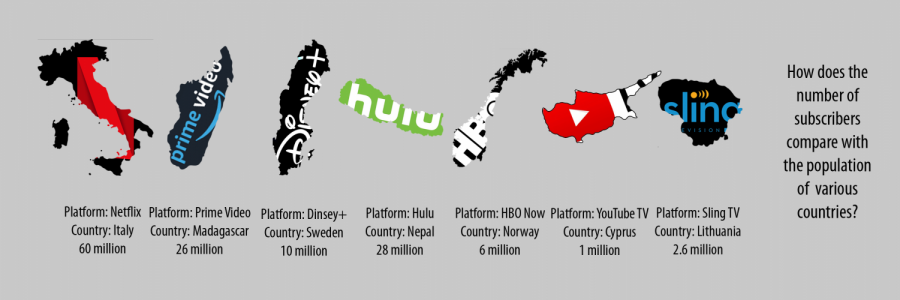Becoming main-’stream’
Streaming services provide alternative options to cable television
The above visual shows countries with similar populations to the amount of subscribers each platform has.
With Disney+ being the lastest streaming service launch, many different streaming services and internet-based television services have been made available at the touch of your fingertips. Whether it’s a romantic comedy or spine-chilling thriller, each of these platforms provides a wide range of movies, shows and documentaries. That begs the question: which one is the best?
Amazon launched Prime Video, originally called Amazon Unbox, in 2006 as one of the first video-streaming services. However, it was originally only available in the US until 2011. Amazon also started producing its own original content in 2013, with the platform now having more than 80 original television programs and more than 45 original films. Prime Video is currently available through a membership of $8.99 per month or available through an Amazon Prime membership, which costs $12.99 per month. There are an estimated 26 million people who are subscribed to Prime Video, currently placing it as the second-largest video-streaming platform.
Netflix started as a rival to Blockbuster in 1997 as an online way to rent DVDs via mail. It was not until 2007 that Netflix became an online streaming service. Since 2016, Netflix has been available worldwide. Netflix has produced over 300 original movies, as well as over 300 original shows such as “Stranger Things,” “13 Reasons Why” and “House of Cards.” Netflix currently offers its subscription at three different prices: $8.99 per month for the basic plan, which has no HD, $12.99 per month for the standard plan, which includes HD, and $15.99 per month for the premium plan, which includes both HD and Ultra HD. Netflix is currently the largest online video-streaming service at over 60 million subscribers.
Disney+ was just launched on Nov. 12 and has already amassed more than 10 million subscribers. The service, owned by Disney, provides users with both old and new movies and television shows for subscribers to enjoy. Disney+ also allows subscribers with original content, such as a live-action remake of “Lady and the Tramp” and “The Mandalorian” that were released alongside the launch of Disney+. Consumers can subscribe to Disney+ with a plan at $6.99 per month.
Hulu was first available to the public starting in 2008. Hulu was a joint venture from several companies including Comcast, MySpace, Yahoo! and Facebook, but Disney now currently owns Hulu. Hulu currently has over 20 original series, such as “The Handmaid’s Tale” and “The Path.” The basic Hulu plan costs $5.99 per month and includes ads, while an ad-free version costs $11.99 per month. Hulu also offers a plan which includes live TV that has over 60 channels, as well as additional channels that can be added on for an additional price. The basic Hulu + Live TV plan costs $44.99 per month and includes ads for Hulu, while the no-ad version of Hulu costs $50.99 per month. Hulu’s customer base exceeds over 28 million subscribers.
YouTube TV launched in 2017 and is operated by Alphabet Inc., the owners of Google and YouTube. It features over 70 different channels, such as NBC, Fox, CNN, Discovery and ESPN. The service now covers around 90 percent of the United States. YouTube TV allows for live viewing as well as the ability to create recordings that are stored for up to nine months. The service currently costs $49.99 per month, along with over one million subscribers.
The television network HBO began offering HBO Now, a service that allows consumers to view any HBO content at any time. HBO Now contains many hit movies and TV shows from the network over the years, such as “Game of Thrones,” “Westworld,” “The Sopranos,” “Robocop,” “Annie Hall” and more. The current subscription plan costs $14.99 per month and allows for access to more than 300 original HBO series. Currently, the service has around 5 million subscribers.
Dish TV founded Sling TV in 2015 as an alternative way to get television. Sling has multiple plans for consumers depending on what networks they want to pay for. For example, one plan includes networks like National Geographic, TruTV and TLC while another plan includes networks like Freeform, ESPN and Disney. The two different plans cost $25 per month each or both plans can be bought at once for $40 per month. Sling TV also has additional channels that can be bought for extra money such as Starz and Showtime. Sling has about 2.6 million subscribers.
While each of these platforms offers a wide variety of shows and movies, it’s best to figure out which one is the best for each person. Whether someone is looking for a new series to binge-watch or a movie to sing along to, each of these services has something for everyone.



